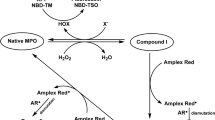Abstract
It was shown with the spin trap α-(4-pyridyl-1-oxide)-N-tert-butylnitrone that myeloperoxidase (MPO) in the presence of its substrates H2O2 and Cl− as well as activated neutrophils destroy tert-butyl hydroperoxide producing two adducts of O-centered radicals which were identified as peroxyl and alcoxyl radicals. Inhibitory analysis performed with traps of hypochlorite (taurine and methionine), free radical scavengers (2,6-di-tret-butyl-4-methylphenol and mannitol), and MPO inhibitors (salicylhydroxamic acid and 4-aminobenzoic acid hydrazide) revealed that the destruction of the hydroperoxide group in the presence of isolated MPO or activated neutrophils was directly caused by the activity of MPO: some radical intermediates appeared as a result of the chlorination cycle of MPO at the stage of hypochlorite generation, whereas the other radicals were produced independently of hypochlorite, presumably with involvement of the peroxidase cycle of MPO. The data suggest that the activated neutrophils located in the inflammatory foci and secreting MPO into the extracellular space can convert hydroperoxides into free radicals initiating lipid peroxidation and other free radical reactions and, thus, promoting destruction of protein-lipid complexes (biological membranes, blood lipoproteins, etc.).
Similar content being viewed by others
Abbreviations
- LPO:
-
lipid peroxidation
- 4-POBN:
-
α-(4-pyridyl-1-oxide)-N-tret-butylnitrone
- EPR:
-
electron paramagnetic resonance
- BHT:
-
2,6-di-tret-butyl-4-methylphenol
- MPO:
-
myeloperoxidase
REFERENCES
Halliwell, B., and Gutteridge, J. M. C. (1999) Free Radicals in Biology and Medicine, Oxford University Press.
Vladimirov, Yu. A., and Archakov, A. I. (1972) Lipid Peroxidation in Biological Membranes [in Russian], Nauka, Moscow.
Kagan, V. E., Orlov, O. N., and Prilipko, L. L. (1986) Advances in Science and Technology. Ser. Biophysics [in Russian], Vol. 18, VINITI, Moscow, pp. 5–135.
Panasenko, O. M., Arnhold, J., and Sergienko, V. I. (2002) Biol. Membr. (Moscow), 19, 403–434.
Panasenko, O. M. (1997) BioFactors, 6, 181–190.
Klebanoff, S. J., and Clark, R. A. (1978) The Neutrophil: Function and Clinical Disorders, Elsevier North Holland, Amsterdam.
Arnhold, J. (2004) Biochemistry (Moscow), 69, 4–9.
Shafran, M. G. (1981) Usp. Sovr. Biol., 92, 365–379.
Panasenko, O. M., Osipov, A. N., Chekanov, A. V., Arnhold, J., and Sergienko, V. I. (2002) Biochemistry (Moscow), 67, 880–888.
Osipov, A. N., Panasenko, O. M., Chekanov, A. V., and Arnhold, J. (2002) Free Rad. Res., 36, 749–754.
Zubarev, V. E. (1984) Spin Trap Approach. Application in Chemistry, Biology, and Medicine [in Russian], MGU Publishers, Moscow.
Boyum, A. (1964) Nature, 204, 793–794.
Boyum, A. (1968) Scand. J. Clin. Lab. Invest., 21, 74–89.
Duling, D. R. (1994) J. Magn. Reson., B104, 105–110.
Kettle, A. J., and Winterbourn, C. C. (1994) Meth. Enzymol., 233, 502–512.
Kettle, A. J., and Winterbourn, C. C. (1997) Red. Report, 3, 3–15.
Deby-Dupont, G., Deby, C., and Lamy, M. (1999) Intensivmed., 36, 500–513.
Bakkenist, R. J., De Boer, J. E. G., Plat, H., and Wever, R. (1980) Biochim. Biophys. Acta, 613, 337–348.
Kettle, A. J., and Winterbourn, C. C. (1991) Biochem. Pharmacol., 41, 1485–1492.
Osipov, A. N., Savov, V. M., Yax'yaev, A. V., Zubarev, V. E., Azizova, O. A., Kagan, V. E., and Vladimirov, Yu. A. (1984) Biofizika, 29, 533–536.
Osipov, A. N., Moravskii, A. P., Shuvalov, V. F., Azizova, O. A., and Vladimirov, Yu. A. (1980) Biofizika, 25, 234–238.
Furtmueller, P. G., Burner, U., Jantschko, W., Regelsberger, G., and Obinger, C. (2000) FEBS Lett., 484, 139–143.
Howard, J. A., and Ingold, K. U. (1968) J. Am. Chem. Soc., 90, 1056–1058.
Rice-Evans, C., Leake, D., Bruckdorfer, K. R., and Diplock, A. T. (1996) Free Rad. Res., 25, 285–311.
Author information
Authors and Affiliations
Corresponding author
Additional information
__________
Translated from Biokhimiya, Vol. 70, No. 9, 2005, pp. 1209–1217.
Original Russian Text Copyright © 2005 by Panasenko, Chekanov, Arnhold, Sergienko, Osipov, Vladimirov.
Rights and permissions
About this article
Cite this article
Panasenko, O.M., Chekanov, A.V., Arnhold, J. et al. Generation of Free Radicals during Decomposition of Hydroperoxide in the Presence of Myeloperoxidase or Activated Neutrophils. Biochemistry (Moscow) 70, 998–1004 (2005). https://doi.org/10.1007/s10541-005-0215-z
Received:
Revised:
Issue Date:
DOI: https://doi.org/10.1007/s10541-005-0215-z



